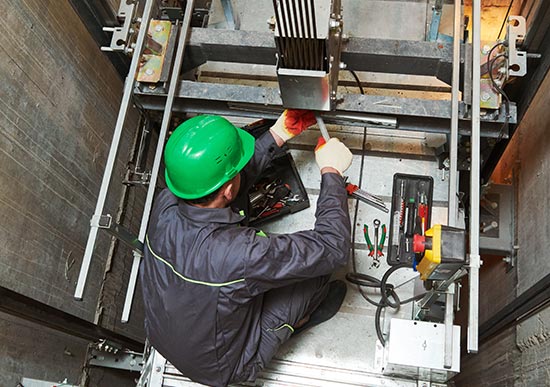A Thorough Technique to Enhancing Performance With Strategic Lift Repair Service Techniques
A systematic and strategic method to lift repair service and upkeep is critical to make the most of efficiency and lessen downtime. By dealing with usual lift concerns, implementing positive upkeep procedures, and developing targeted repair work plans, centers can maximize their lift systems to operate at peak performance levels.
Value of Lift Performance Optimization
Understanding the relevance of maximizing lift performance is crucial for making certain dependable and effective upright transportation systems in numerous structures and frameworks. Lifts are crucial elements of modern-day facilities, offering upright flexibility for residents and items within structures of differing heights. By maximizing lift performance, structure proprietors and center managers can boost user experience, improve power efficiency, and rise general operational efficiency.
Efficient lift efficiency optimization includes various elements, consisting of rate, ability, power safety and security, consumption, and maintenance requirements. Properly maximized lifts can lower wait times for customers, particularly in high-traffic structures, resulting in improved fulfillment and performance. Additionally, maximized lifts add to energy cost savings by utilizing advanced control systems and innovations that reduce power usage without compromising efficiency.

Identifying Common Lift Issues
Identifying common lift issues is vital for maintaining the operational effectiveness and security of vertical transport systems in structures. Acknowledging these concerns can help stop malfunctions, reduce downtime, and expand the life expectancy of the lift equipment. One usual problem that building managers and upkeep teams commonly come across is uneven or jerky movements throughout operation. This concern can be indicative of issues with the lift's motor, control system, or even the placement of the lift vehicle.
An additional widespread lift concern is strange noises originating from the lift shaft or machinery space. These noises can range from grinding or scuffing sounds to loud clunking sounds, all of which might indicate underlying mechanical concerns that call for immediate focus. Furthermore, frequent door breakdowns, such as doors not opening or shutting properly, can disrupt the smooth circulation of passengers and present security dangers.
Applying Proactive Maintenance Procedures
To maximize the performance and longevity of lift systems, aggressive upkeep measures play an essential function in making sure functional integrity and safety. lift servicing companies. Applying aggressive upkeep involves methodically inspecting, maintenance, and fixing elements prior to they stop working, thus avoiding pricey downtime and possible security hazards. Consistently arranged inspections can aid recognize minor concerns prior to they rise right into major troubles, eventually prolonging the lifespan of lift systems
One trick facet of positive upkeep is developing a comprehensive maintenance routine based on manufacturer recommendations and market site web finest practices. This timetable must detail tasks such as lubrication, alignment checks, and part substitutes at defined periods. In addition, executing condition monitoring techniques, such as resonance evaluation and thermal imaging, can assist spot very early signs of wear or malfunction.
In addition, training maintenance staff on appropriate assessment methods and preventative upkeep procedures is important for the successful execution of aggressive maintenance procedures. By promoting a culture of aggressive maintenance within an organization, lift systems can run at peak efficiency degrees, reducing disturbances and ensuring the security of customers.
Creating Targeted Repair Strategies
Upon assessing the maintenance documents and performance information, the engineering team can create targeted fixing plans to deal with particular issues and enhance lift system performance. These repair service plans are customized to the recognized troubles, making sure that sources are focused on solving vital problems efficiently. By focusing on repair work based upon their effect on performance and safety, the targeted repair strategies assist lessen downtime and upkeep prices while making best use of the lift system's integrity.
Creating these plans involves a detailed evaluation of the lift system elements, consisting of electric motors, cables, brakes, and control systems. Via this comprehensive evaluation, the design team can determine the source of any type of malfunctions or deterioration in efficiency. This information is then used to create a roadmap for the repair service process, describing the required steps, timeline, and sources called for to address each issue properly.
Furthermore, targeted fixing plans may include preventative procedures to enhance the lift system's durability and efficiency. By proactively attending to prospective issues prior to they escalate, these strategies add to the overall efficiency and security of the lift system.
Using Data-Driven Insights
Using the power of data-driven insights is important in enhancing lift system performance and maintenance efficiency. By leveraging information analytics, lift drivers can make informed choices that cause boosted functional effectiveness and expense savings. Through the analysis of historic efficiency fads, data and patterns can be identified, making it possible for anticipating upkeep strategies to be applied. These predictive upkeep approaches aid stop unexpected malfunctions, decrease downtime, and expand the lifespan of lift systems.

Conclusion
Finally, optimizing lift efficiency is look at these guys essential for ensuring efficiency and security in buildings. By determining usual lift concerns, applying aggressive maintenance measures, establishing targeted repair strategies, and making use of data-driven insights, organizations can enhance performance and lessen downtime. It is necessary to take a comprehensive method to lift repair service approaches to optimize functional efficiency and guarantee the long life of lift systems.
By dealing with common lift problems, applying positive maintenance actions, and developing targeted fixing plans, centers can maximize their lift systems to run at peak efficiency levels.One more widespread lift problem is unusual sounds emanating from the lift shaft or machinery area.Upon evaluating the maintenance records and efficiency data, the design team can establish targeted repair service plans to address details problems and maximize lift system capability. By prioritizing repair work based on their effect on performance and safety, the targeted repair work strategies aid decrease downtime and maintenance expenses while optimizing the lift system's reliability.
It is crucial to take an extensive method to raise fixing methods to maximize operational effectiveness and make sure the longevity of lift systems.